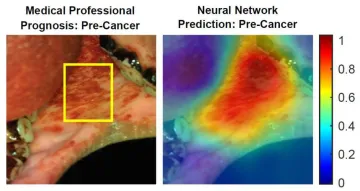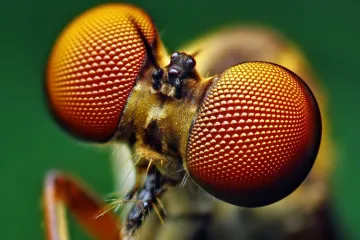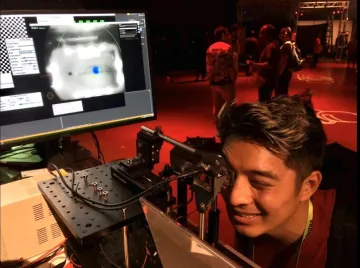Another Wavelength: Kevin Chew Figueroa

This month in Another Wavelength, we chat with M.S. Student Kevin Chew Figueroa. Kevin is currently a Research Assistant in Professor Rongguang Liang's Imaging & Applied Optics Laboratory.
Where are you from?
I was born in Pasadena, California, and grew up in the adjacent city of South Pasadena. I now live in Pasadena two blocks from the Hospital where I was born.
What brought you to study optics?
The following combination of academic endeavors has led me to pursue the study of Optical Sciences:
- A Master’s degree in Computer Science at the University of Southern California with a focus (pun intended) in Machine Learning, Computer Graphics, and Discrete Differential Geometry;
- An undergraduate degree in Electrical & Computer Engineering;
- Research experience in Material Sciences and Biochemistry assisting in the wet lab at Caltech and Cal State Los Angeles; and
- Of course, my thirst for knowledge, drive for innovation, and my passionate curiosity/incessant questions.

I have already earned a Master’s from USC in Computer Science (Data Science). I am currently a MS Student at UArizona and will be applying to the PhD in Optical Sciences for Fall 2021. I am a RA in Professor Liang’s Imaging & Applied Optics Laboratory. For now, I am assisting with the development of Deep Learning: Transfer Learning Models/mobile computer-aided systems for supporting medical professionals with diagnosing Oral Cancer.
Who is your hero in science?
For mathematics it would have to be Claude Shannon, the father of Information Theory. However, for science I must go with Albert Einstein. As he said: “The important thing is not to stop questioning. Curiosity has its own reason for existing.” It allows us to look into the window of uncertainty with a sense of familiarity and an overwhelming feeling of joy to expand our creative minds. “I have no special talent. I am only passionately curious.”
Describe your research in 20 words or fewer.
My research goal is to create a symbiotic relationship between Optical Sciences and Neural Networks, which has the potential to generate new disruptive technologies, trigger novel collaborations across scientific fields, and spark new paradigms in both Computer Science and Optical Sciences.
Describe your research in 200 words or fewer.
I often think about how science and engineering look to the natural world for creative inspiration to everyday scientific and technological challenges. Just as there is not a single perfect algorithm for every engineering task, I think that there is not one perfect optical system. Dragonflies’ compound eyes possess a large viewing angle and ability to detect fast movement; Eagles’ eyes allow them to spot prey from miles away. Nature has been working on applications of physical sciences for much longer than humans have walked this Earth. And yet, while many imaging/optical systems to date still utilize configurations synonymous with that of the human eye, and if we wish to capitalize on the discoveries of nature, the question becomes: “How do we calculate/utilize the geometry of these nature inspired systems?”

From a more general perspective, both Optical Sciences and Neural Networks each alone have their own unique challenges, but conversely each possess exceptional capabilities that complement each other. A neural network, while synonymous with nature’s brain can be utilized as a powerful/parallelizable differential equation solver for solving a range of geometries and equations, however is still a digital filter and no matter how much it zooms in on a jpeg image it will not become any less pixelated. Similarly, unique optical systems can be designed with a zoom/magnification capability not limited to pixilation, and yet calculating these complicated/unique Freeform Optics geometries is non-trivial.

In nature, we already see the brain and eyes working in concert. In practice, I think hybridizing these two topics together may result in systems that would massively parallelize/automate the calculation of optical geometries, surpass classical limitations caused by the laws of physics, side step typical quantization/pixilation errors caused by the discrete nature of digital systems, and ultimately outperform existing state of the art methods.
Consequently, I think that optics and neural networks share a potential technological relationship much like the evolutionary one shared in nature by the eyes and the brain. By following this biological inspired research path of marrying the two fields, I believe that much like the eyes and brain coevolve, Optical Sciences and Machine Learning may evolve together as well.
Applications of this emerging research are already underway for rapidly generating custom/tailored Photonic Crystals (PhCs) in the hundreds to thousands at MIT; Rendering 3D Computer Generated Holography (CGH) with real time performance at 1080p at Stanford; Developing Fully Optical Neural Networks performing passively w/o additional energy input and at the speed of light at UCLA.
Name three neat facts about
- I am one of three kids. My younger sisters Emily and Samantha are twins. All three of us are currently pursuing graduate degrees. Education has always been very important in our family.
- As an undergraduate, I began doing independent research and expanded my home lab in our garage. I built my own 3D Printer, CNC Router, PC, photolithography system (in-progress), and also set up a wet lab with vacuum chamber, chemical oven, analytical balance, etc.
- I have always been known to ask lots of questions. I always have questions, especially about topics I do not know. I cannot help myself from asking. Some would say I am a serial inquirer. I also love to brainstorm with others on new ideas and concepts. I believe that diversity and curiosity drives creativity and new ideas.
Citation:
- P. Patton,. Seeing With Insect Eyes. A Moment of Science - Indiana Public Media, Indiana Public Media, July 2014, indianapublicmedia.org/amomentofscience/insect-eyes.php.
